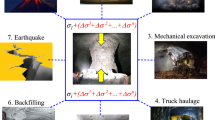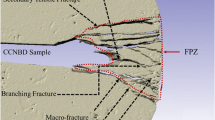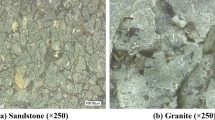Abstract
This research presents the results of laboratory experiments during the investigation of tensile strength–strain characteristics of Brisbane tuff disc specimens under static and diametral cyclic loading. Three different cyclic loading methods were used; namely, sinusoidal cyclic loading, type I and II increasing cyclic loading with various amplitude values. The first method applied the stress amplitude−cycle number (s–n) curve approach to the measurement of the indirect tensile strength (ITS) and fracture toughness (K IC) values of rocks for the first time in the literature. The type I and II methods investigated the effect of increasing cyclic loading on the ITS and K IC of rocks. For Brisbane tuff, the reduction in ITS was found to be 30 % under sinusoidal loading, whereas type I and II increasing cyclic loading caused a maximum reduction in ITS of 36 %. The maximum reduction of the static K IC of 46 % was obtained for the highest amplitude type I cyclic loading tested. For sinusoidal cyclic loading, a maximum reduction of the static K IC of 30 % was obtained. A continuous irreversible accumulation of damage was observed in dynamic cyclic tests conducted at different amplitudes and mean stress levels. Scanning electron microscope images showed that fatigue damage in Brisbane tuff is strongly influenced by the failure of the matrix because of both inter-granular fracturing and trans-granular fracturing. The main characteristic was grain breakage under cyclic loading, which probably starts at points of contact between grains and is accompanied by the production of very small fragments, probably due to frictional sliding within the weak matrix.















Similar content being viewed by others
References
Al-Shayea NA (2005) Crack propagation trajectories for rocks under mixed mode I-II fracture. Eng Geol 81:84–97
Atkinson BK (1984) Subcritical crack growth in geological materials. J Geophys Res 89:4077–4114
Atkinson C, Smelser RE, Sanchez J (1982) Combined mode fracture via the cracked Brazilian disk test. Int J Fracture 18(4):279–291
Attawel PB, Farmer IW (1973) Fatigue behaviour of rock. Int J Rock Mech Min 10(1):1–9
Awaji H, Sato S (1978) Combined mode fracture toughness measurement by the disk test. J Eng Mater Technol 100:175–182
Bagde MN, Pedros V (2005) Fatigue properties of intact sandstone samples subjected to dynamic uniaxial cyclical loading. Int J Rock Mech Min 42(2):237–250
Bienawskie ZT (1967) Mechanism of brittle rock fracture: part II-experimental studies. Int J Rock Mech Min Sci Geomech Abs 4(4):407–423
Burdine NT (1963) Rock failure under dynamic failure conditions. SPE J 3(1):1–8
Celestino TB, Bortolucci AA (1995) Determination of rock fracture toughness under creep and fatigue: the 35th U.S. symposium on rock mechanics. New York, pp 147–52
Chong KP, Kuruppu MD (1984) New specimen for fracture toughness determination of rock and other materials. Int J Fract 26:59–62
Costin LS, Holcomb DJ (1981) Time-dependent failure of rock under cyclic loading. Tectonophysics 79(3–4):279–296
Erarslan N, Williams DJ (2012a) The damage mechanism of rock fatigue and its relationship to the fracture toughness of rocks. Int J Rock Mech Min Sci 56:15–26
Erarslan N, Williams DJ (2012b) Mechanism of rock fatigue damage in terms of fracturing modes. Int J of Fatigue 43:76–89
Evans AG (1980) Fatigue in ceramics. Int J Fract 16(6):485–498
Evans AG, Fuller ER (1974) Crack propagation in ceramic materials under cyclic loading conditions. Metall Trans 5(1):27–29
Griffith AA (1920) The phenomena of rupture and flow in solids philos. Trans R Soc Lond 221:163–198
Guo H, Aziz NI, Schmidt LC (1993) Rock fracture toughness determination Brazilian test. Eng Geol 33:177–188
Hadley K (1976) The effect of cyclic stress on dilatancy: another look. J Geophys Res 81(14):2471–2474
Haimson BC (1978) Effect of cyclic loading on rock. In: Dynamic geotechnical testing, ASTM STP 654. American Society for Testing and Materials, West Conshohocken, pp 228–245
Haimson BC, Kim CM (1971) Mechanical behaviour of rock under cyclic fatigue. Rock Mech 3:845–863
Hoek E (1968) Brittle fracture of rocks. In: Stagg KG, Zienkiewicz OC (eds) Rock mechanics in engineering practice. John Wiley, London
Inglis CE (1913) Stresses in a plate due to the presence of cracks and sharp corners. Trans Inst Naval Archit 55:219
ISRM (1978) International society for rock mechanics. Suggested methods for determining tensile strength of rock materials. Int J Rock Mech Min Sci Geomech Abs 15:99–103
ISRM (1995) Suggested method for determining mode I fracture toughness using cracked chevron notched Brazilian disk (CCNBD) specimens. Int J Rock Mech Min Sci Geomech Abs 32(1):57–64
Lajtai EZ (1971) A theoretical and experimental evaluation of the Griffith theory of brittle fracture. Tectonophysics 11:129–156
Nemat-Nasser S, Deng H (1994) Strain rate effect on brittle failure in compression. Acta Metall Mater 42:1013–1024
Ouchterlony F (1988) Suggested methods for determining the fracture toughness of rock. Int J Rock Mec Min Sci Geomech Abs 25(2):71–96
Shetty DK, Rosenfield AR, Duckworth WH (1985) Fracture toughness of ceramics measured by a chevron notch diametral compression test. J Am Ceram Soc 68(12):C325–C327
Singh SK (1989) Fatigue and strain hardening behaviour of greywacke from the flagstaff formation, NSW. Eng Geol 26:171–179
Tao Z, Mo H (1990) An experimental study and analysis of the behaviour of rock under cyclic loading. Int J Rock Mech Min Sci Geomech Abs 27:51–56
Whittaker BN, Singh RN, Sun G (1992) Rock fracture mechanics-principles, design and applications. Elsevier, Amsterdam
Zhang ZX, Kou SQ, Yu J, Yu Y, Jiang LG, Lindqvist PA (1999) Effects of loading rate on rock fracture. Int J Rock Mech Min 36(5):597–611
Zhao J, Li HB (2000) Experimental determination of dynamic tensile properties of granite. Int J Rock Mech Min 37:851–861
Acknowledgments
Acknowledgement is made to Leighton Contractors who provided core samples of Brisbane tuff from the CLEM7 Project and to Professor Ted Brown, Les McQueen, Mark Funkhauser and Rob Morphet of Golder Associates Pty Ltd for their assistance and advice. The work described forms part of the first author’s PhD research carried out within the then Golder Geomechanics Centre at The University of Queensland. The first author was supported by an Australian Postgraduate Award/UQRS and the Golder Geomechanics Centre.
Author information
Authors and Affiliations
Corresponding author
Rights and permissions
About this article
Cite this article
Erarslan, N., Alehossein, H. & Williams, D.J. Tensile Fracture Strength of Brisbane Tuff by Static and Cyclic Loading Tests. Rock Mech Rock Eng 47, 1135–1151 (2014). https://doi.org/10.1007/s00603-013-0469-5
Received:
Accepted:
Published:
Issue Date:
DOI: https://doi.org/10.1007/s00603-013-0469-5




